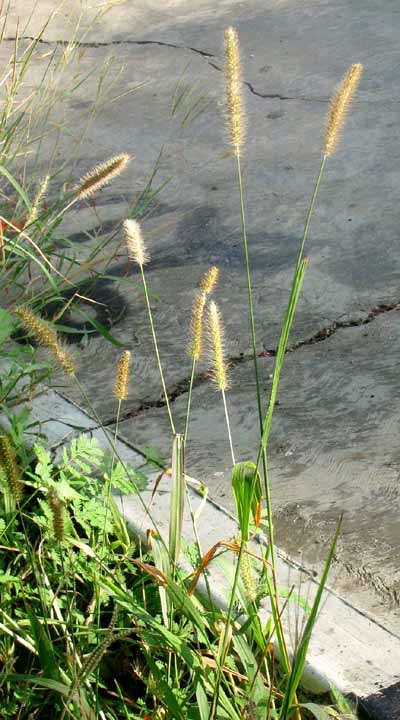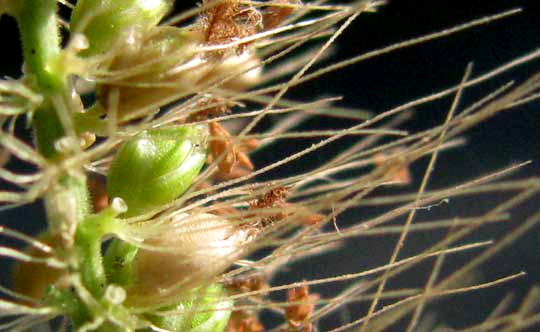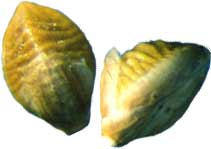

Foxtail is one of the easiest of all grass types to recognize, because of its fingerlike inflorescences packed with roundish spikelets and abundant soft bristles, as seen in the pictures. However, about 140 species of foxtail, genus Setaria, are recognized worldwide, with 27 listed for North America, so sometimes identifying them to species level is tricky. Of North America's 27 species, nine are invasive, tending to occupy disturbed, weedy areas. Most of us think of foxtail grasses as weeds, despite all the native ones.

The average foxtail inflorescence contains hundreds if not thousands of closely packed, roundish spikelets, as shown at the left. In that picture, the brownish items atop each spikelet are withered anthers which have dumped their pollen. The stiff, slender bristles are particularly interesting. On our Grass Flowers page where the basics of Grass Family flower structure are discussed, there's no mention of bristles, so these bristles are something special.
 At the right we can start understanding what foxtail bristles are. That's a spikelet plucked from a foxtail inflorescence. The fuzzy purple item atop the spikelet consists of style branches of one of the spikelet's few florets. Notice that the spikelet has a short stem, or pedicel. If foxtail inflorescences were of the spike type -- and from a distance they seem to be -- the spikelet's pedicel would be attached directly to the inflorescence's axis, or rachis.
At the right we can start understanding what foxtail bristles are. That's a spikelet plucked from a foxtail inflorescence. The fuzzy purple item atop the spikelet consists of style branches of one of the spikelet's few florets. Notice that the spikelet has a short stem, or pedicel. If foxtail inflorescences were of the spike type -- and from a distance they seem to be -- the spikelet's pedicel would be attached directly to the inflorescence's axis, or rachis.  But you can see that the spikelet is attached to some kind of branched stump, and it was this branched stump that was attached to the rachis. The picture at the left shows several spikelets on one branched stump, the stump having been removed from the inflorescence's rachis. The schematic below shows the main inflorescence types, and there's only one type in which branches of the main axis rebranch: Panicles
But you can see that the spikelet is attached to some kind of branched stump, and it was this branched stump that was attached to the rachis. The picture at the left shows several spikelets on one branched stump, the stump having been removed from the inflorescence's rachis. The schematic below shows the main inflorescence types, and there's only one type in which branches of the main axis rebranch: Panicles

Foxtail inflorescence are panicles which may look like spikes. The bristles are modified panicle branches. They're modified to be slender, straight and stiff, and they're modified to lack spikelets at their outer ends.

And where does all this lead to? As with flowers in general, the ovary of a foxtail floret matures into a fruit, which in foxtail's case is a caryopsis-type fruit. A caryopsis is a dry, one-seeded fruit which doesn't split open at maturity, and in which the ovary wall is united with the seed coat, so that the fruit is indistinguishable from a seed. In a general sense we can call them grains. Those are much-magnified foxtail grains at the right, much relished by small seed-eating birds such as sparrows and finches, and small rodents.